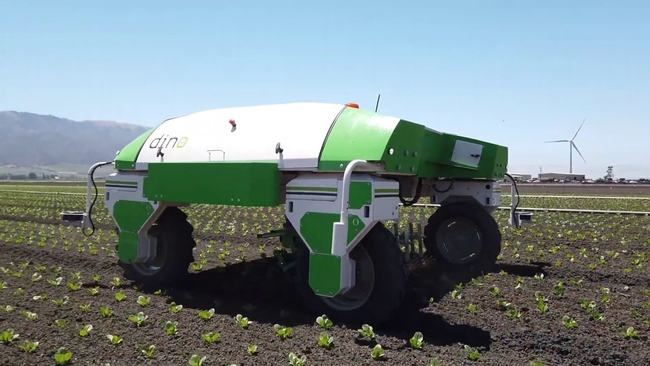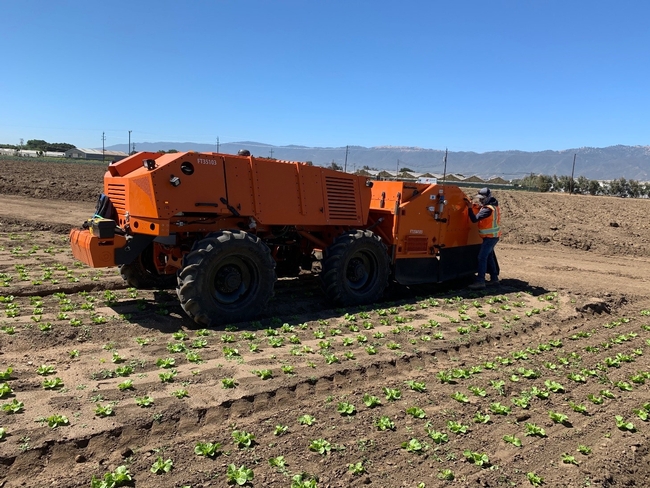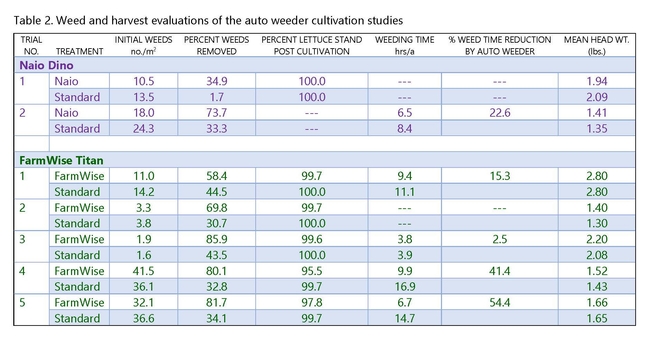Elizabeth Mosqueda is an Assistant Professor at the California State University, Monterey Bay.
Richard Smith is a Vegetable Crop Production and Weed Science Farm Advisor with UC Cooperative Extension.
Steve Fennimore is a Cooperative Extension Weed Specialist at UC Davis.
BACKGROUND
Automated weeder technology has evolved significantly over the past decade. The technology used by auto weeders is similar to that used by the auto thinners: cameras detect plants, a computer processes the image and makes decisions about which plants to keep and which to remove and then activates the kill mechanism. Automated weeders remove weeds from inside the uncultivated band (3-5 inches wide) left around the seedline and unreachable by standard cultivation. The kill mechanism used by the currently available machines is either a split blade that opens around keeper plants (e.g. Robovator and Steketee IC) or a spinning blade that avoids the keeper plants by placing them in a notch in the blade (e.g. Garford Robocrop). In 2015, evaluations found that Robovator and Steketee IC autoweeders removed 51% of the weeds in the seedlines and reduced follow up hand weeding time by 37%. From these studies we observed that auto weeders were not miracle workers, in that they required a relatively low to moderate population of weeds in order to operate effectively. As such good weed control in prior rotations or a good preemergent weed control program was needed to keep weeds at a moderate level. However, new developments in crop/weed detection may improve this issue. In addition, auto weeders do not remove all the weeds in the seedline because they cannot remove weeds that are too close to the crop plants without risking damaging them. And finally, the automated weeders are currently not capable of removing lettuce doubles in direct seeded lettuce fields, and as a result, it is still necessary to have a crew pass through the field following the passage of the auto weeder, if for no other reason than to remove double lettuce plants. The main impact of the auto weeders is to reduce the amount of time that follow up hand weeding/double removal takes. This then brings up the hard question for a grower – does the reduced amount of time that follow up weeding/double removal takes, make up for the cost of running the automated weeder through the field. What is the economic threshold to run an autoweeder?
In 2020 we evaluated two new autonomous weeders. These machines are designed to run without a driver and are intended to be set up to weed a field on their own. In these studies, the machines always had someone accompany them through the fields, as auto weeding lettuce fields is still in the research and development phase. We conducted, evaluations of the Naio Dino platform (Photo 1) and the FarmWise Titan (Photo 2). We evaluated initial weed populations and subsequent follow-up hand weeding to better understand the relationship between weed pressure and the time savings for subsequent hand removal of weeds and doubles.


METHODS
Two trials were conducted with the Naio Dino autonomous robotic platform equipped with finger weeders and five trials were conducted with the FarmWise Titan autonomous weeder which used a split knife that closes between crop plants, thereby taking out weeds in the seedline, and opens around the keeper plants. Auto cultivation was carried out following thinning (except Dino Trial No. 2 was cultivated prior to thinning) and were compared with standard cultivation which leaves a 4-5 inch wide band around the seedline. Pre and post cultivation weed and stand counts were made of a 6-inch wide band around the seedline to determine the efficacy of standard and auto cultivation. Weeding time of the treatments was evaluated by measuring the time it took members from a commercial hand weeding crew to pass through the treatment rows. Weeding time was then converted to hours per acre. Stand counts and harvest evaluations were conducted to determine if the auto weeders caused damage to the stand or to crop plants. See Table 1 for trial details.
RESULTS
Naio Dino evaluations: This cultivator used finger weeders and removed more weeds from the seedline than standard cultivation (Table 2). It reduced weeding time in trial No. 2 and did not reduce the stand or mean head weight of the lettuce.
FarmWise Titan evaluations: Five trials were conducted with this implement. The FarmWise Titan removed a higher percent of weeds from the seedline in all trials and reduced subsequent hand weeding time in three of four evaluations. More time was required to hand weed fields with higher initial weed populations (Figure 1). According to the data in Figure 1, at high weed densities, subsequent weeding time was reduced using an auto weeder by 12% for each increase in weed density of 10/m2. The FarmWise Titan did not significantly reduce the stand of lettuce or reduce the mean head weight of lettuce.
Overall, auto weeders removed about twice the number of weeds than standard cultivation from the 6-inch band around the seedline and reduced subsequent hand weeding/double removal by 4 hours/acre (Table 3). They did not reduce the stands of lettuce or affect mean head weight of lettuce and were therefore, did not damage lettuce plants to a significant degree. In general, the use of auto weeders appears to be clearly justified in fields with higher weed densities. However, other pressures may also spur the move to automated weeders such as increasing labor costs and lower labor availability.



